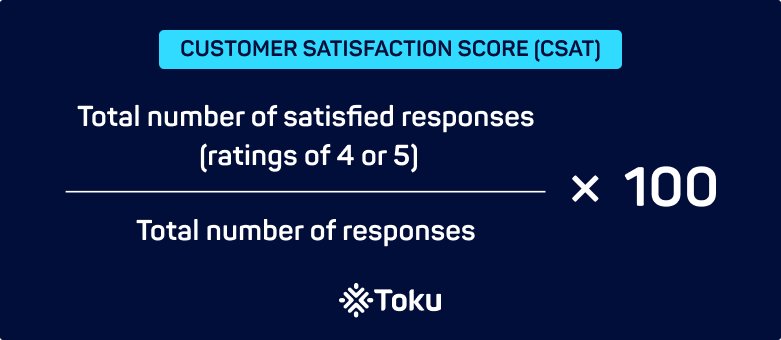Discover how ChatGPT and generative AI could revolutionize customer experience in contact centres. Learn about their capabilities and limitations, and explore realistic use cases for supporting agents and supervisors in this context.
Understanding customer contentment is crucial for any business aiming to thrive. This is where the Customer Satisfaction Score, commonly referred to as CSAT, becomes an essential metric.
What is the customer satisfaction (CSAT) score?
It is a metric used to gauge the level of satisfaction consumers experience with a company’s offerings, be it products or services.
Typically, businesses gather CSAT data from individual customers, calculating an average to gain insight into the collective customer mood. By consistently monitoring this contact centre metric, similarly to how one might track a Net Promoter Score (NPS), organisations can discern the direct effects of their customer experience enhancement efforts over time.
The formula is simple:

Total up the number of positive responses (commonly those who answered 4 or 5 on a 5-point scale, or 6 to 7 on a 7-point scale). Then, divide this sum by the total number of responses collected and multiply the result by 100.
Why are CSAT scores important for contact centre managers?
CSAT scores are vital because they provide immediate feedback on customer sentiment towards a brand’s offerings. They can pinpoint areas of excellence or highlight aspects in need of improvement. High CSAT scores are often correlated with customer loyalty and can lead to positive word-of-mouth, while low scores may indicate underlying issues that could harm the business if not addressed.
Regularly assessing CSAT is instrumental for businesses to better understand and enhance their customer journey.
Real-world use cases
Insurance Claims Process: Imagine a customer has just interacted with a customer service representative to submit an insurance claim. By promptly asking for feedback on this interaction, the insurance company can gauge the effectiveness of their customer support. Comparing these ratings over time, especially after implementing new service protocols or training programs, can provide insights into how these changes are impacting customer satisfaction.
E-Commerce Delivery Experience: In the case of an e-commerce platform, measuring customer satisfaction scores immediately after a product delivery can provide valuable feedback on the entire delivery process. This data can be especially telling if measured before and after implementing new delivery strategies or partnerships. It helps the platform understand if these logistical changes are translating into a better customer experience.
What is a good CSAT score?
A good CSAT score varies by industry, but generally, a score between 75 and 85 percent is considered good. A score above 90 percent is considered excellent.
While it’s good to aim for a high score, it is more important for contact centre managers to monitor CSAT regularly and aim for continuous improvement.
What are the pros and cons of CSAT Scores?
Pros
Simplicity: The surveys often consist of a single query, allowing for swift, two-click responses from users.
Easy to understand: The metric is straightforward, making it easy for all stakeholders to grasp.
Benchmarking: It allows for comparison against industry standards or competitors.
Cons
Lack of depth: CSAT can fail to capture the complexity of customer sentiment.
Lack of details: CSAT scores typically measure overall satisfaction with a product or service, but they may not capture specific details or nuances of the customer experience. Also, the CSAT score may not provide enough context to understand the underlying reasons behind the satisfaction or dissatisfaction.
How to improve your CSAT score
1. Train your agents: Ensure they have the skills and knowledge to provide excellent customer service.
2. Delve deeper: Given that CSAT scores often lack detailed context, it’s essential for companies to probe deeper for more details to get a comprehensive understanding of the customer experience before acting on the feedback.
3. Be transparent about your waiting-times: Minimise customer wait-time frustrations by offering transparent estimates for how long they can expect to wait in queue for a response. Also, you can offer alternatives such as texting, callbacks, and chatbots, easing the load on agents and enhancing service efficiency.
Drive growth with satisfied customers
A high CSAT score is an indicator of customers’ happiness and is often a direct result of a company’s commitment to excellence.
By regularly measuring and thoughtfully responding to CSAT scores, businesses can build stronger relationships with their customers, improve loyalty, and drive growth.
Remember, a satisfied customer is not just a repeat customer but also a potential ambassador, often bringing new customers through positive testimonials. Therefore, maintaining a keen eye on your CSAT scores is crucial. However, it’s also important to gain a more comprehensive understanding of customer satisfaction and the overall customer experience by combining CSAT with other feedback mechanisms and key performance indicators.
 V K Sanjeed
V K Sanjeed 



 Benson Chan
Benson Chan 
 Nora Huin
Nora Huin